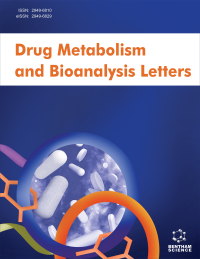- Home
- A-Z Publications
- Drug Metabolism and Bioanalysis Letters
- Previous Issues
- Volume 15, Issue 2, 2022
Drug Metabolism and Bioanalysis Letters - Volume 15, Issue 2, 2022
Volume 15, Issue 2, 2022
-
-
The Impact of the Coronavirus (COVID-19) Infection on the Drug- Metabolizing Enzymes Cytochrome P450s
More LessCoronaviruses cause disease in humans and animals. In 2019 a novel coronavirus was first characterized in Wuhan, China causing acute respiratory disease and designating the severe acute respiratory syndrome coronavirus 2 (SARS-CoV-2) or COVID-19. The COVID-19 spread to all cities of China and in 2020 to the whole world. Patients with COVID-19 may recover without medical treatment. However, some patients need m Read More
-
-
-
Mechanism-Based Inhibition of CYP3A Subfamilies by Macrolide Antibiotics and Piperine
More LessAuthors: Toshiro Niwa and Risa IshiiObjective: The mechanism-based inhibition of macrolide antibiotics, such as erythromycin and clarithromycin, and piperine on testosterone 6β-hydroxylation activities by cytochrome P450 (CYP) 3A4, polymorphically expressed CYP3A5, and fetal CYP3A7 were compared. Methods: 6β-Hydroxy testosterone was determined by high-performance liquid chromatography. Results: Although preincubation with erythromycin a Read More
-
-
-
The Role of Plant-based Products in the Prevention of Neurological Complications
More LessAuthors: Ankul S. S and Chitra VellapandianBackground: Neurological complications are most likely to be fatal and cause loss of ability to function or care for self. These include Alzheimer’s disease and cognitive impairment. The main aim of the review is to determine the effects of various drugs and their cognitive risk with the need to opt for herbal therapy as an adjuvant in treating neurological conditions like Alzheimer’s disease with lesser-known side effects. Methods Read More
-
-
-
Therapeutic Drug Monitoring as a Tool for Therapy Optimization
More LessAuthors: Merin Babu and Keechilat PavithranThe use of pharmacotherapy for improving healthcare in society is increasing. A vast majority of patients have either received subtherapeutic treatment (which could result from low pharmacokinetics) or experienced adverse effects due to the toxic levels of the drug. The medicines used to treat chronic conditions, such as epilepsy; cardiovascular diseases; oncological, neurological, and psychiatric disorders, require routine Read More
-
-
-
Assessment of Nano Lipid Carrier Loaded Transdermal Patch of Rizatriptan Benzoate
More LessAuthors: Sayani Bhattacharyya and Lavanya NanjareddyBackground: Migraine is a neurological disorder and is accompanied by different painful episodes. Hence, the maintenance of a steady-state concentration of drugs can be beneficial for patients suffering from migraine. The present investigation focuses on the development of nano lipid carriers (NLCs) loaded with transdermal patches of rizatriptan benzoate to sustain the effect of the drug for the enhancement of therap Read More
-
-
-
ZY12201: A Potent TGR5 Agonist: Identification of a Novel Pan CYP450 Inhibitor Tool Compound for In-Vitro Assessment
More LessAuthors: Poonam Giri, Lakshmikant Gupta, Anil Rathod, Vipul Joshi, Shyamkumar Giri, Nirmal Patel, Sameer Agarwal and Mukul R JainBackground: Identification of clinical Drug-Drug Interaction (DDI) risk is an important aspect of drug discovery and development owing to poly-pharmacy in present-day clinical therapy. Drug Metabolizing Enzymes (DME) play important roles in the efficacy and safety of drug candidates. Hence, the evaluation of a New Chemical Entity (NCE) as a victim or perpetrator is very crucial for DDI risk mitigation. ZY12201 (2-((2-(4 Read More
-
Volumes & issues
Most Read This Month
Article
content/journals/dmbl
Journal
10
5
false
en


